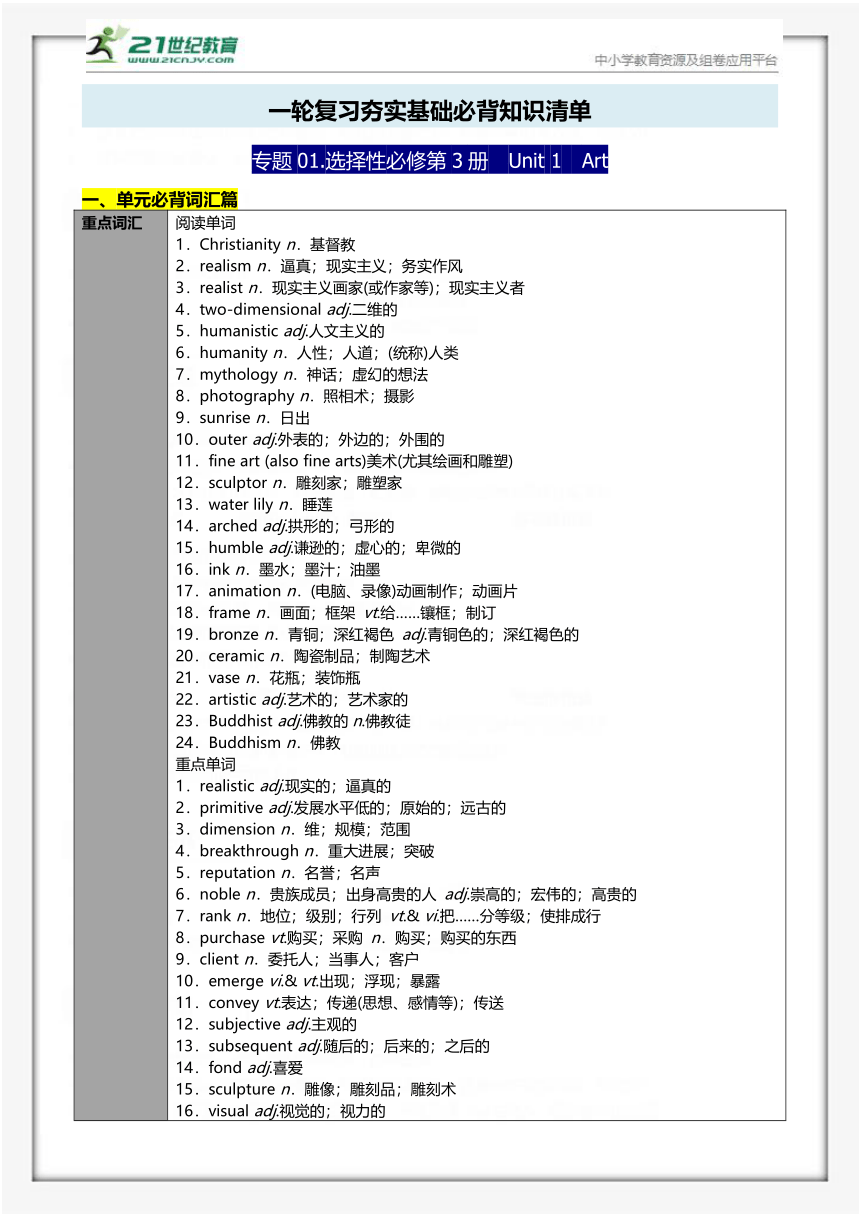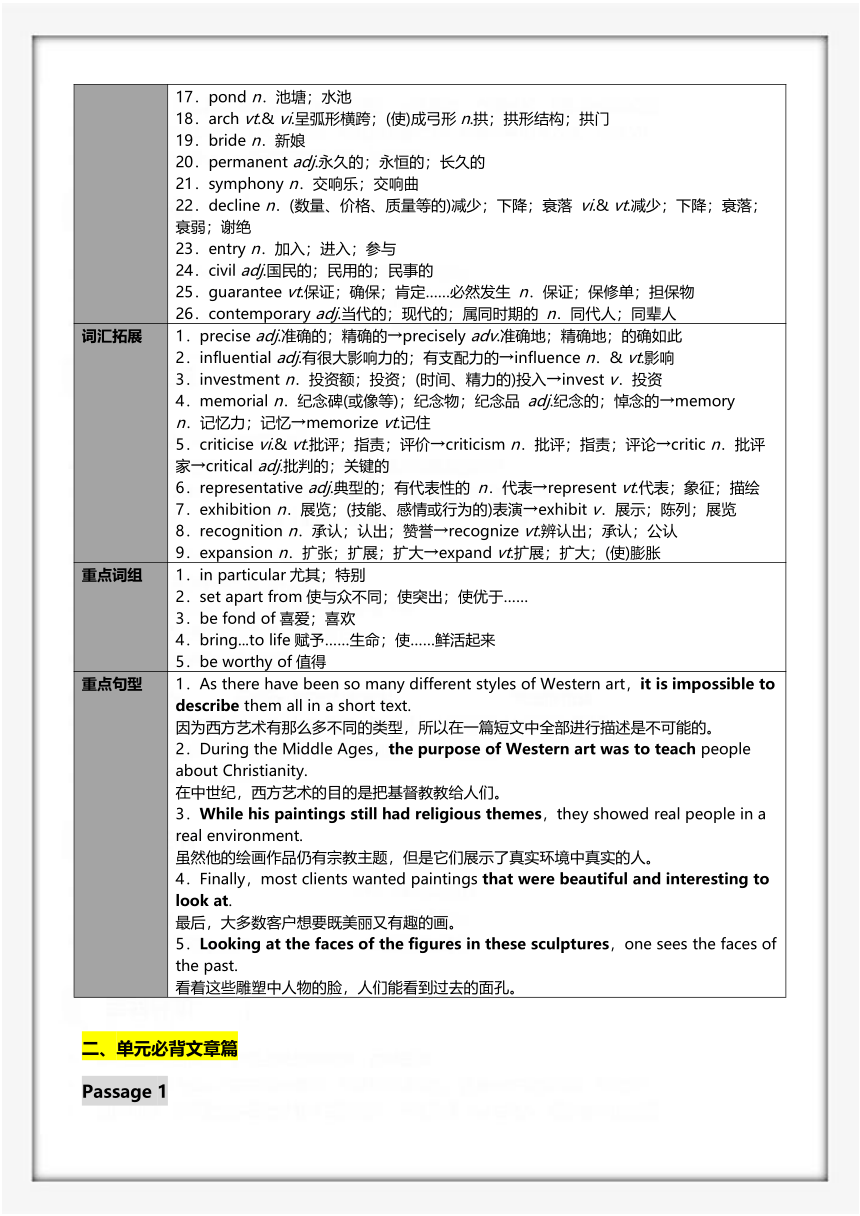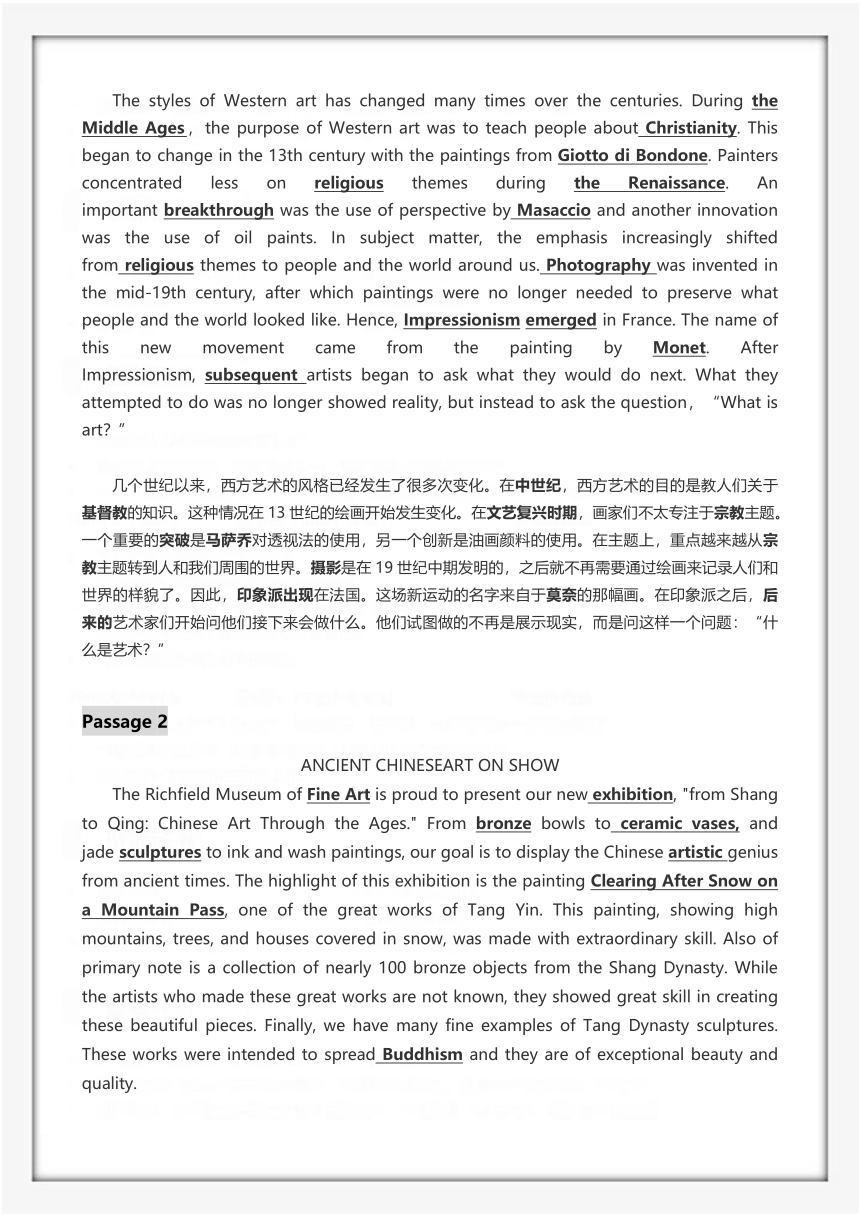(人教版2019)高考英语 一轮复习夯实基础必背知识清单 专题01. 选择性必修第3册 Unit 1 Art
文档属性
| 名称 | (人教版2019)高考英语 一轮复习夯实基础必背知识清单 专题01. 选择性必修第3册 Unit 1 Art |  | |
| 格式 | docx | ||
| 文件大小 | 101.1KB | ||
| 资源类型 | 试卷 | ||
| 版本资源 | 人教版(2019) | ||
| 科目 | 英语 | ||
| 更新时间 | 2022-11-18 18:05:52 | ||
图片预览



文档简介
一轮复习夯实基础必背知识清单
专题01.选择性必修第3册 Unit 1 Art
一、单元必背词汇篇
重点词汇 阅读单词 1.Christianity n.基督教 2.realism n.逼真;现实主义;务实作风 3.realist n.现实主义画家(或作家等);现实主义者 4.two-dimensional adj.二维的 5.humanistic adj.人文主义的 6.humanity n.人性;人道;(统称)人类 7.mythology n.神话;虚幻的想法 8.photography n.照相术;摄影 9.sunrise n.日出 10.outer adj.外表的;外边的;外围的 11.fine art (also fine arts)美术(尤其绘画和雕塑) 12.sculptor n.雕刻家;雕塑家 13.water lily n.睡莲 14.arched adj.拱形的;弓形的 15.humble adj.谦逊的;虚心的;卑微的 16.ink n.墨水;墨汁;油墨 17.animation n.(电脑、录像)动画制作;动画片 18.frame n.画面;框架 vt.给……镶框;制订 19.bronze n.青铜;深红褐色 adj.青铜色的;深红褐色的 20.ceramic n.陶瓷制品;制陶艺术 21.vase n.花瓶;装饰瓶 22.artistic adj.艺术的;艺术家的 23.Buddhist adj.佛教的n.佛教徒 24.Buddhism n.佛教 重点单词 1.realistic adj.现实的;逼真的 2.primitive adj.发展水平低的;原始的;远古的 3.dimension n.维;规模;范围 4.breakthrough n.重大进展;突破 5.reputation n.名誉;名声 6.noble n.贵族成员;出身高贵的人 adj.崇高的;宏伟的;高贵的 7.rank n.地位;级别;行列 vt.& vi.把……分等级;使排成行 8.purchase vt.购买;采购 n.购买;购买的东西 9.client n.委托人;当事人;客户 10.emerge vi.& vt.出现;浮现;暴露 11.convey vt.表达;传递(思想、感情等);传送 12.subjective adj.主观的 13.subsequent adj.随后的;后来的;之后的 14.fond adj.喜爱 15.sculpture n.雕像;雕刻品;雕刻术 16.visual adj.视觉的;视力的 17.pond n.池塘;水池 18.arch vt.& vi.呈弧形横跨;(使)成弓形n.拱;拱形结构;拱门 19.bride n.新娘 20.permanent adj.永久的;永恒的;长久的 21.symphony n.交响乐;交响曲 22.decline n.(数量、价格、质量等的)减少;下降;衰落 vi.& vt.减少;下降;衰落;衰弱;谢绝 23.entry n.加入;进入;参与 24.civil adj.国民的;民用的;民事的 25.guarantee vt.保证;确保;肯定……必然发生 n.保证;保修单;担保物 26.contemporary adj.当代的;现代的;属同时期的 n.同代人;同辈人
词汇拓展 1.precise adj.准确的;精确的→precisely adv.准确地;精确地;的确如此 2.influential adj.有很大影响力的;有支配力的→influence n.& vt.影响 3.investment n.投资额;投资;(时间、精力的)投入→invest v.投资 4.memorial n.纪念碑(或像等);纪念物;纪念品 adj.纪念的;悼念的→memory n.记忆力;记忆→memorize vt.记住 5.criticise vi.& vt.批评;指责;评价→criticism n.批评;指责;评论→critic n.批评家→critical adj.批判的;关键的 6.representative adj.典型的;有代表性的 n.代表→represent vt.代表;象征;描绘 7.exhibition n.展览;(技能、感情或行为的)表演→exhibit v.展示;陈列;展览 8.recognition n.承认;认出;赞誉→recognize vt.辨认出;承认;公认 9.expansion n.扩张;扩展;扩大→expand vt.扩展;扩大;(使)膨胀
重点词组 1.in particular尤其;特别 2.set apart from使与众不同;使突出;使优于…… 3.be fond of喜爱;喜欢 4.bring...to life赋予……生命;使……鲜活起来 5.be worthy of值得
重点句型 1.As there have been so many different styles of Western art,it is impossible to describe them all in a short text. 因为西方艺术有那么多不同的类型,所以在一篇短文中全部进行描述是不可能的。 2.During the Middle Ages,the purpose of Western art was to teach people about Christianity. 在中世纪,西方艺术的目的是把基督教教给人们。 3.While his paintings still had religious themes,they showed real people in a real environment. 虽然他的绘画作品仍有宗教主题,但是它们展示了真实环境中真实的人。 4.Finally,most clients wanted paintings that were beautiful and interesting to look at. 最后,大多数客户想要既美丽又有趣的画。 5.Looking at the faces of the figures in these sculptures,one sees the faces of the past. 看着这些雕塑中人物的脸,人们能看到过去的面孔。
单元必背文章篇
Passage 1
The styles of Western art has changed many times over the centuries. During the Middle Ages,the purpose of Western art was to teach people about Christianity. This began to change in the 13th century with the paintings from Giotto di Bondone. Painters concentrated less on religious themes during the Renaissance. An important breakthrough was the use of perspective by Masaccio and another innovation was the use of oil paints. In subject matter, the emphasis increasingly shifted from religious themes to people and the world around us. Photography was invented in the mid-19th century, after which paintings were no longer needed to preserve what people and the world looked like. Hence, Impressionism emerged in France. The name of this new movement came from the painting by Monet. After Impressionism, subsequent artists began to ask what they would do next. What they attempted to do was no longer showed reality, but instead to ask the question,“What is art?”
几个世纪以来,西方艺术的风格已经发生了很多次变化。在中世纪,西方艺术的目的是教人们关于基督教的知识。这种情况在13世纪的绘画开始发生变化。在文艺复兴时期,画家们不太专注于宗教主题。一个重要的突破是马萨乔对透视法的使用,另一个创新是油画颜料的使用。在主题上,重点越来越从宗教主题转到人和我们周围的世界。摄影是在19世纪中期发明的,之后就不再需要通过绘画来记录人们和世界的样貌了。因此,印象派出现在法国。这场新运动的名字来自于莫奈的那幅画。在印象派之后,后来的艺术家们开始问他们接下来会做什么。他们试图做的不再是展示现实,而是问这样一个问题:“什么是艺术?”
Passage 2
ANCIENT CHINESEART ON SHOW
The Richfield Museum of Fine Art is proud to present our new exhibition, "from Shang to Qing: Chinese Art Through the Ages." From bronze bowls to ceramic vases, and jade sculptures to ink and wash paintings, our goal is to display the Chinese artistic genius from ancient times. The highlight of this exhibition is the painting Clearing After Snow on a Mountain Pass, one of the great works of Tang Yin. This painting, showing high mountains, trees, and houses covered in snow, was made with extraordinary skill. Also of primary note is a collection of nearly 100 bronze objects from the Shang Dynasty. While the artists who made these great works are not known, they showed great skill in creating these beautiful pieces. Finally, we have many fine examples of Tang Dynasty sculptures. These works were intended to spread Buddhism and they are of exceptional beauty and quality.
里奇菲尔德美术馆很自豪地展示了我们的新展览,“从商朝到青朝:历代中国艺术”。从青铜碗到陶瓷花瓶,从玉器雕塑到水墨画,我们的目标是展示中国古代的艺术天分。本次展览的亮点是唐寅的杰作之一—《函关雪霁图》。这幅画运用了非凡的技巧,展示了高山、树木和被白雪覆盖的房子。同样十分重要的(看点)是来自商代的近百件青铜器藏品。虽然不清楚创作这些伟大作品的艺术家是谁,但他们在创作这些美丽的作品时表现出了高超的技艺。最后,我们有许多唐代的雕塑精品。这些作品的目的是传播佛教,而且它们外观精美、品质上乘。
三、单元必背写作素材篇
读后续写惊讶描写
一、高级词汇
名词:Amazement;astonishment
形容词:Astonished;amazed;surprised;shocked;stunned(使惊愕);open-mouthed(瞠目结舌的,目瞪口呆的)
二、满分短语
gape at 张口结舌地看
gasp in astonishment 惊得倒吸一口气
blink in surprise 吃惊地睁眼
be shocked beyond words 惊讶得说不出话来
dead/be numb with shock 惊呆了
to one's surprise/astonishment /amazement令某人吃惊的是
a bolt from the blue 晴天霹雳
三、必背好句
1、(肢体)动作/语言描写+情感词汇:
Hearing the unexpected news, Mary froze with shock, as if rooted to the spot.
听到这个意外的消息,玛丽呆住了,动弹不得。
The car was gone in seconds, leaving Alice shaking her head in disbelief.
几秒钟后汽车开走了,爱丽丝难以置信地摇头。
My brother's sudden visit home was a complete surprise. We all stared wide-eyed at him.
我哥哥突然回家探望,完全出乎我们的意料。我们惊奇地睁大眼睛看着他。
2、(面部)动作描写+情感词汇:
A spark of flashed/passed across his face. He froze/was stunned there, staring at me with wide eyes.
他脸上闪过一丝惊奇。他惊得瞪大眼睛看着我。
The moment I opened the box, my eyes grew wide/widened in great surprise/astonishment.
我一打开盒子,就惊奇地睁大了眼睛。
We froze, our mouths dropping/hanging open in surprise.我们呆住了,惊奇地张大了嘴。
My jaw dropped/fell in astonishment when I saw the size of the audience.
看到观众如此之多,我惊讶得张口结舌。
3. 心理活动描写+情感词汇:
Astonished, I realized that the boys had also recognized what her action meant.
我惊讶地发现,孩子们也明白她的举动意味着什么。
It amazed me that no one had thought of the idea sooner.
居然没有人早点想到这个办法,这令我吃惊。
My father's reaction astonished me. How could he be so calm!
父亲的反应让我很惊讶,他怎么会如此镇静!
1.I still remember the shock that rooted me flat against the wall.
我仍然记得当时惊呆了,靠在墙上,一动不动。
2.I stared at him in shock and a faint sound of surprise escaped my throat.我惊愕地盯着他,不禁发出轻轻的惊愕声。
3.Tom fainted away on the spot and fell into unconsciousness.
汤姆当场晕倒,失去了知觉。
4.When Mary heard the bad news, her eyes widened further and her mouth opened.
当玛丽听到这个坏消息时,她的眼睛睁得更大,嘴也张着。
5.Rose froze with shock, as if rooted on the ground. 罗斯惊呆了,好像扎根在地上一样。
1.He breathed a sigh of relief.他松了一口气。
2.He felt greatly relieved and his joy was immense.他感到如释重负,快乐无限。
3.He could feel the tension released and a warmth spread through his body.
他能感觉到紧张感的释放,一种温暖的感觉传遍全身。
4.His breathing grew slower, as a new calm settled over him.
他重新获得新的平静,呼吸减慢了。
5.He regained his calmness and could think straight clearly.
他恢复了镇静,头脑清醒。
四、单元必背语法篇
Grammar 不定式作表语
【观察例句】
1.Perhaps the best way to understand Western art is to look at the development of Western painting over the centuries.
2.During the Middle Ages,the purpose of Western art was to teach people about Christianity.
3.In this work,Monet's aim was to convey the light and movement in the scene.
4.What they attempted to do was no longer show reality,but instead to ask the question,“What is art?”
【归纳用法】
一、不定式作表语的用法
1.表目的
The purpose of education is to develop a fine personality in children.
教育的目的是发展儿童完美的品格。
2.表示事态发展的结果、预期的结果、不幸的命运或语言。
You must speak out,if we are to remain friends.
如果我们还想继续做朋友的话,你就必须痛痛快快地把话都说出来。
3.用于第一人称问句,表示征求意见。
What am I to say if they ask me the question
要是他们问我这个问题,我该怎么回答呢?
4.表示“同意、安排、命令、决定、劝告、意愿、禁止”等。
They are to marry next week.
他们将在下周结婚。(安排)
[即学即练1] 单句语法填空
①His ambition is (become) a famous novelist.
②Our most important task now is (make) a plan.
③The function of Louis Sullivan's architecture was (provide) large uninterrupted floor areas and to allow ample light into the interior.
【答案】1.to become2.to make3.to provide
二、不定式和现在分词作表语的区别
1.动词不定式作表语,通常表示具体的或将来的动作。
Our first assignment was to read two short stories.
我们的首要任务是读两篇短篇故事。
2.现在分词作表语,表示抽象的一般行为。
My work is teaching Chinese.
我的工作是教语文。
[即学即练2] 单句语法填空
①The most important thing is (negotiate) with them about the future of the plant.
②What we expect from you is (work) hard rather than hardly working.
三、不定式作表语to的省略
1.当主语thing这个词被动词不定式修饰时,作表语的不定式符号“to”可以省略。
The thing for us to do is accept the challenge.
我们要做的事情就是要接受挑战。
2.当主语是带有动词“do”的由“what”引导的主语从句时,其表语的动词不定式符号“to”可以省略。
What they want to do is have a good sleep.
他们想要做的就是好好睡一觉。
3.当句子主语被动词“do”作谓语的定语从句修饰的anything,all,all that,the only thing,the only way,或者thing前面有序数词first,second,last等修饰时,其表语动词不定式的符号“to”可以省略。
The only thing you have to do is press the button.
你要做的唯一的事情就是按一下按钮。
Ⅰ.单句语法填空
1.My work is (clean) the room every day.
2.To do two things at a time is (do) neither.
3.The next step is (make) sure that you know exactly what is required.
4.You must be patient and persistent if you are (succeed).
5.What am I (do) if I have no money
【答案】1. to clean2.to do3.to make4.to succeed5.to do
专题01.选择性必修第3册 Unit 1 Art
一、单元必背词汇篇
重点词汇 阅读单词 1.Christianity n.基督教 2.realism n.逼真;现实主义;务实作风 3.realist n.现实主义画家(或作家等);现实主义者 4.two-dimensional adj.二维的 5.humanistic adj.人文主义的 6.humanity n.人性;人道;(统称)人类 7.mythology n.神话;虚幻的想法 8.photography n.照相术;摄影 9.sunrise n.日出 10.outer adj.外表的;外边的;外围的 11.fine art (also fine arts)美术(尤其绘画和雕塑) 12.sculptor n.雕刻家;雕塑家 13.water lily n.睡莲 14.arched adj.拱形的;弓形的 15.humble adj.谦逊的;虚心的;卑微的 16.ink n.墨水;墨汁;油墨 17.animation n.(电脑、录像)动画制作;动画片 18.frame n.画面;框架 vt.给……镶框;制订 19.bronze n.青铜;深红褐色 adj.青铜色的;深红褐色的 20.ceramic n.陶瓷制品;制陶艺术 21.vase n.花瓶;装饰瓶 22.artistic adj.艺术的;艺术家的 23.Buddhist adj.佛教的n.佛教徒 24.Buddhism n.佛教 重点单词 1.realistic adj.现实的;逼真的 2.primitive adj.发展水平低的;原始的;远古的 3.dimension n.维;规模;范围 4.breakthrough n.重大进展;突破 5.reputation n.名誉;名声 6.noble n.贵族成员;出身高贵的人 adj.崇高的;宏伟的;高贵的 7.rank n.地位;级别;行列 vt.& vi.把……分等级;使排成行 8.purchase vt.购买;采购 n.购买;购买的东西 9.client n.委托人;当事人;客户 10.emerge vi.& vt.出现;浮现;暴露 11.convey vt.表达;传递(思想、感情等);传送 12.subjective adj.主观的 13.subsequent adj.随后的;后来的;之后的 14.fond adj.喜爱 15.sculpture n.雕像;雕刻品;雕刻术 16.visual adj.视觉的;视力的 17.pond n.池塘;水池 18.arch vt.& vi.呈弧形横跨;(使)成弓形n.拱;拱形结构;拱门 19.bride n.新娘 20.permanent adj.永久的;永恒的;长久的 21.symphony n.交响乐;交响曲 22.decline n.(数量、价格、质量等的)减少;下降;衰落 vi.& vt.减少;下降;衰落;衰弱;谢绝 23.entry n.加入;进入;参与 24.civil adj.国民的;民用的;民事的 25.guarantee vt.保证;确保;肯定……必然发生 n.保证;保修单;担保物 26.contemporary adj.当代的;现代的;属同时期的 n.同代人;同辈人
词汇拓展 1.precise adj.准确的;精确的→precisely adv.准确地;精确地;的确如此 2.influential adj.有很大影响力的;有支配力的→influence n.& vt.影响 3.investment n.投资额;投资;(时间、精力的)投入→invest v.投资 4.memorial n.纪念碑(或像等);纪念物;纪念品 adj.纪念的;悼念的→memory n.记忆力;记忆→memorize vt.记住 5.criticise vi.& vt.批评;指责;评价→criticism n.批评;指责;评论→critic n.批评家→critical adj.批判的;关键的 6.representative adj.典型的;有代表性的 n.代表→represent vt.代表;象征;描绘 7.exhibition n.展览;(技能、感情或行为的)表演→exhibit v.展示;陈列;展览 8.recognition n.承认;认出;赞誉→recognize vt.辨认出;承认;公认 9.expansion n.扩张;扩展;扩大→expand vt.扩展;扩大;(使)膨胀
重点词组 1.in particular尤其;特别 2.set apart from使与众不同;使突出;使优于…… 3.be fond of喜爱;喜欢 4.bring...to life赋予……生命;使……鲜活起来 5.be worthy of值得
重点句型 1.As there have been so many different styles of Western art,it is impossible to describe them all in a short text. 因为西方艺术有那么多不同的类型,所以在一篇短文中全部进行描述是不可能的。 2.During the Middle Ages,the purpose of Western art was to teach people about Christianity. 在中世纪,西方艺术的目的是把基督教教给人们。 3.While his paintings still had religious themes,they showed real people in a real environment. 虽然他的绘画作品仍有宗教主题,但是它们展示了真实环境中真实的人。 4.Finally,most clients wanted paintings that were beautiful and interesting to look at. 最后,大多数客户想要既美丽又有趣的画。 5.Looking at the faces of the figures in these sculptures,one sees the faces of the past. 看着这些雕塑中人物的脸,人们能看到过去的面孔。
单元必背文章篇
Passage 1
The styles of Western art has changed many times over the centuries. During the Middle Ages,the purpose of Western art was to teach people about Christianity. This began to change in the 13th century with the paintings from Giotto di Bondone. Painters concentrated less on religious themes during the Renaissance. An important breakthrough was the use of perspective by Masaccio and another innovation was the use of oil paints. In subject matter, the emphasis increasingly shifted from religious themes to people and the world around us. Photography was invented in the mid-19th century, after which paintings were no longer needed to preserve what people and the world looked like. Hence, Impressionism emerged in France. The name of this new movement came from the painting by Monet. After Impressionism, subsequent artists began to ask what they would do next. What they attempted to do was no longer showed reality, but instead to ask the question,“What is art?”
几个世纪以来,西方艺术的风格已经发生了很多次变化。在中世纪,西方艺术的目的是教人们关于基督教的知识。这种情况在13世纪的绘画开始发生变化。在文艺复兴时期,画家们不太专注于宗教主题。一个重要的突破是马萨乔对透视法的使用,另一个创新是油画颜料的使用。在主题上,重点越来越从宗教主题转到人和我们周围的世界。摄影是在19世纪中期发明的,之后就不再需要通过绘画来记录人们和世界的样貌了。因此,印象派出现在法国。这场新运动的名字来自于莫奈的那幅画。在印象派之后,后来的艺术家们开始问他们接下来会做什么。他们试图做的不再是展示现实,而是问这样一个问题:“什么是艺术?”
Passage 2
ANCIENT CHINESEART ON SHOW
The Richfield Museum of Fine Art is proud to present our new exhibition, "from Shang to Qing: Chinese Art Through the Ages." From bronze bowls to ceramic vases, and jade sculptures to ink and wash paintings, our goal is to display the Chinese artistic genius from ancient times. The highlight of this exhibition is the painting Clearing After Snow on a Mountain Pass, one of the great works of Tang Yin. This painting, showing high mountains, trees, and houses covered in snow, was made with extraordinary skill. Also of primary note is a collection of nearly 100 bronze objects from the Shang Dynasty. While the artists who made these great works are not known, they showed great skill in creating these beautiful pieces. Finally, we have many fine examples of Tang Dynasty sculptures. These works were intended to spread Buddhism and they are of exceptional beauty and quality.
里奇菲尔德美术馆很自豪地展示了我们的新展览,“从商朝到青朝:历代中国艺术”。从青铜碗到陶瓷花瓶,从玉器雕塑到水墨画,我们的目标是展示中国古代的艺术天分。本次展览的亮点是唐寅的杰作之一—《函关雪霁图》。这幅画运用了非凡的技巧,展示了高山、树木和被白雪覆盖的房子。同样十分重要的(看点)是来自商代的近百件青铜器藏品。虽然不清楚创作这些伟大作品的艺术家是谁,但他们在创作这些美丽的作品时表现出了高超的技艺。最后,我们有许多唐代的雕塑精品。这些作品的目的是传播佛教,而且它们外观精美、品质上乘。
三、单元必背写作素材篇
读后续写惊讶描写
一、高级词汇
名词:Amazement;astonishment
形容词:Astonished;amazed;surprised;shocked;stunned(使惊愕);open-mouthed(瞠目结舌的,目瞪口呆的)
二、满分短语
gape at 张口结舌地看
gasp in astonishment 惊得倒吸一口气
blink in surprise 吃惊地睁眼
be shocked beyond words 惊讶得说不出话来
dead/be numb with shock 惊呆了
to one's surprise/astonishment /amazement令某人吃惊的是
a bolt from the blue 晴天霹雳
三、必背好句
1、(肢体)动作/语言描写+情感词汇:
Hearing the unexpected news, Mary froze with shock, as if rooted to the spot.
听到这个意外的消息,玛丽呆住了,动弹不得。
The car was gone in seconds, leaving Alice shaking her head in disbelief.
几秒钟后汽车开走了,爱丽丝难以置信地摇头。
My brother's sudden visit home was a complete surprise. We all stared wide-eyed at him.
我哥哥突然回家探望,完全出乎我们的意料。我们惊奇地睁大眼睛看着他。
2、(面部)动作描写+情感词汇:
A spark of flashed/passed across his face. He froze/was stunned there, staring at me with wide eyes.
他脸上闪过一丝惊奇。他惊得瞪大眼睛看着我。
The moment I opened the box, my eyes grew wide/widened in great surprise/astonishment.
我一打开盒子,就惊奇地睁大了眼睛。
We froze, our mouths dropping/hanging open in surprise.我们呆住了,惊奇地张大了嘴。
My jaw dropped/fell in astonishment when I saw the size of the audience.
看到观众如此之多,我惊讶得张口结舌。
3. 心理活动描写+情感词汇:
Astonished, I realized that the boys had also recognized what her action meant.
我惊讶地发现,孩子们也明白她的举动意味着什么。
It amazed me that no one had thought of the idea sooner.
居然没有人早点想到这个办法,这令我吃惊。
My father's reaction astonished me. How could he be so calm!
父亲的反应让我很惊讶,他怎么会如此镇静!
1.I still remember the shock that rooted me flat against the wall.
我仍然记得当时惊呆了,靠在墙上,一动不动。
2.I stared at him in shock and a faint sound of surprise escaped my throat.我惊愕地盯着他,不禁发出轻轻的惊愕声。
3.Tom fainted away on the spot and fell into unconsciousness.
汤姆当场晕倒,失去了知觉。
4.When Mary heard the bad news, her eyes widened further and her mouth opened.
当玛丽听到这个坏消息时,她的眼睛睁得更大,嘴也张着。
5.Rose froze with shock, as if rooted on the ground. 罗斯惊呆了,好像扎根在地上一样。
1.He breathed a sigh of relief.他松了一口气。
2.He felt greatly relieved and his joy was immense.他感到如释重负,快乐无限。
3.He could feel the tension released and a warmth spread through his body.
他能感觉到紧张感的释放,一种温暖的感觉传遍全身。
4.His breathing grew slower, as a new calm settled over him.
他重新获得新的平静,呼吸减慢了。
5.He regained his calmness and could think straight clearly.
他恢复了镇静,头脑清醒。
四、单元必背语法篇
Grammar 不定式作表语
【观察例句】
1.Perhaps the best way to understand Western art is to look at the development of Western painting over the centuries.
2.During the Middle Ages,the purpose of Western art was to teach people about Christianity.
3.In this work,Monet's aim was to convey the light and movement in the scene.
4.What they attempted to do was no longer show reality,but instead to ask the question,“What is art?”
【归纳用法】
一、不定式作表语的用法
1.表目的
The purpose of education is to develop a fine personality in children.
教育的目的是发展儿童完美的品格。
2.表示事态发展的结果、预期的结果、不幸的命运或语言。
You must speak out,if we are to remain friends.
如果我们还想继续做朋友的话,你就必须痛痛快快地把话都说出来。
3.用于第一人称问句,表示征求意见。
What am I to say if they ask me the question
要是他们问我这个问题,我该怎么回答呢?
4.表示“同意、安排、命令、决定、劝告、意愿、禁止”等。
They are to marry next week.
他们将在下周结婚。(安排)
[即学即练1] 单句语法填空
①His ambition is (become) a famous novelist.
②Our most important task now is (make) a plan.
③The function of Louis Sullivan's architecture was (provide) large uninterrupted floor areas and to allow ample light into the interior.
【答案】1.to become2.to make3.to provide
二、不定式和现在分词作表语的区别
1.动词不定式作表语,通常表示具体的或将来的动作。
Our first assignment was to read two short stories.
我们的首要任务是读两篇短篇故事。
2.现在分词作表语,表示抽象的一般行为。
My work is teaching Chinese.
我的工作是教语文。
[即学即练2] 单句语法填空
①The most important thing is (negotiate) with them about the future of the plant.
②What we expect from you is (work) hard rather than hardly working.
三、不定式作表语to的省略
1.当主语thing这个词被动词不定式修饰时,作表语的不定式符号“to”可以省略。
The thing for us to do is accept the challenge.
我们要做的事情就是要接受挑战。
2.当主语是带有动词“do”的由“what”引导的主语从句时,其表语的动词不定式符号“to”可以省略。
What they want to do is have a good sleep.
他们想要做的就是好好睡一觉。
3.当句子主语被动词“do”作谓语的定语从句修饰的anything,all,all that,the only thing,the only way,或者thing前面有序数词first,second,last等修饰时,其表语动词不定式的符号“to”可以省略。
The only thing you have to do is press the button.
你要做的唯一的事情就是按一下按钮。
Ⅰ.单句语法填空
1.My work is (clean) the room every day.
2.To do two things at a time is (do) neither.
3.The next step is (make) sure that you know exactly what is required.
4.You must be patient and persistent if you are (succeed).
5.What am I (do) if I have no money
【答案】1. to clean2.to do3.to make4.to succeed5.to do
